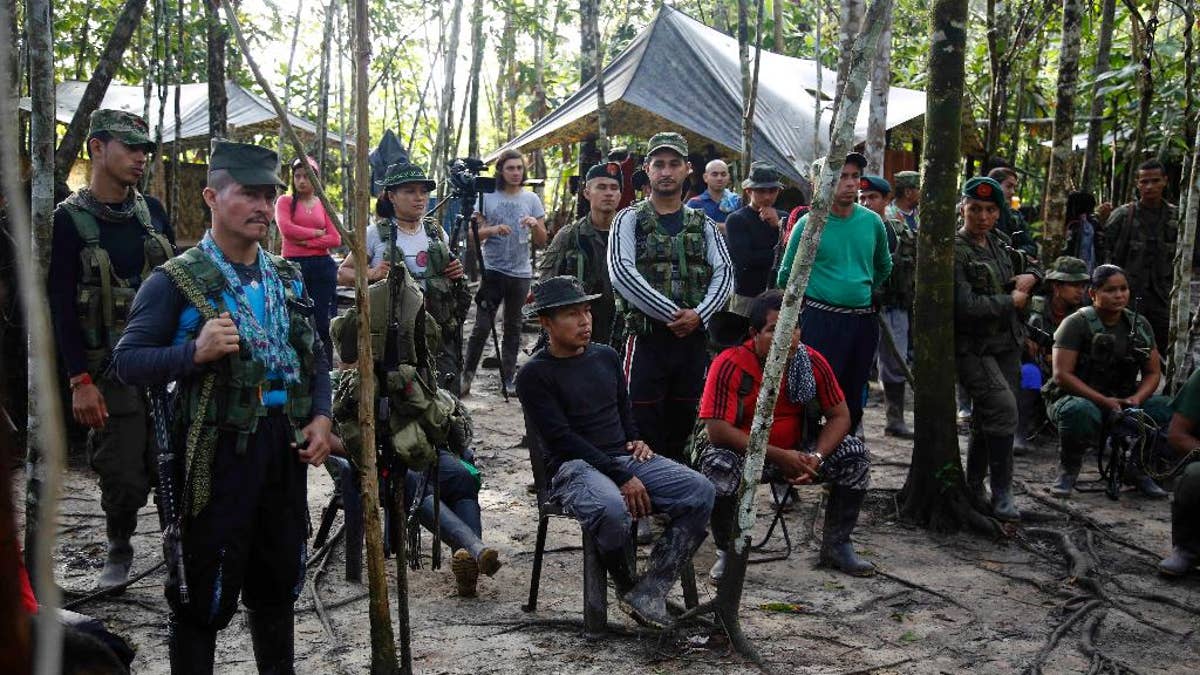
In this Wednesday, Aug. 17, 2016 photo, rebels of the Revolutionary Armed Forces of Colombia southern bloc, FARC, listen to a lecture on the peace process in the southern jungles of Putumayo, Colombia. Martin Corena, the acting commander of the FARC's southern bloc, is calling on President Barack Obama to free a guerrilla leader jailed for more than a decade in the U.S. Corena said Ricardo Palmera’s 60-year sentence in connection to the FARC’s holding captive of three American defense contracts was incompatible with Obama’s support for a peace deal. (AP Photo/Fernando Vergara) (The Associated Press)
BOGOTA, Colombia – A look at Colombia's half-century guerrilla conflict:
HOW IT STARTED
The 1948 assassination of populist firebrand Jorge Eliecer Gaitan led to a political bloodletting known as "La Violencia," or "The Violence." Tens of thousands died, and peasant groups joined with communists to arm themselves. A 1964 military attack on their main encampment led to the creation of the Revolutionary Armed Forces of Colombia, or FARC.
REBEL AIMS
Though nominally Marxist at its founding, the FARC's ideology has never been well defined. It has sought to make the conservative oligarchy share power and prioritized land reform in a country where more than 5 million people have been forcibly displaced, mostly by far-right militias in the service of ranchers, businessmen and drug traffickers. The FARC lost popularity as it turned to kidnapping, extortion and taxes on cocaine production and illegal gold mining to fund its insurgency.
US INVOLVEMENT
In 2000, the United States began sending billions of dollars for counter-narcotics and -insurgency efforts under Plan Colombia, which helped security forces weaken the FARC and kill several top commanders. The State Department classifies the group as a terrorist organization and its leaders face U.S. indictments for what the George W. Bush administration called the world's largest drug-trafficking organization.
THE HUMAN TOLL
More than 220,000 lives have been lost, most of them civilians. In the past two decades, many of the killings were inflicted by the militias, which made peace with the government in 2003. The FARC abducted ranchers, politicians and soldiers who were often held for years in jungle prison camps. Its captives included former presidential candidate Ingrid Betancourt and three U.S. military contractors, all of whom were rescued in 2008.
PEACE EFFORTS
Mid-1980s peace talks collapsed after death squads killed at least 3,000 allies of the FARC's political wing. Another effort fell apart in 2002 after the rebels hijacked an airliner to kidnap a senator. The current talks have been going on since 2012 in Havana.
AGREEMENTS REACHED
In late June, negotiators announced an agreement on a bilateral cease-fire and a blueprint for how an estimated 7,000 FARC fighters will demobilize and lay down their weapons. Accords have also been reached on land reform, combatting drug trafficking, the guerrillas' political participation and punishing war crimes on both sides. The sides formally agreed to the cease-fire and disarmament agreement at a ceremony in Cuba.
